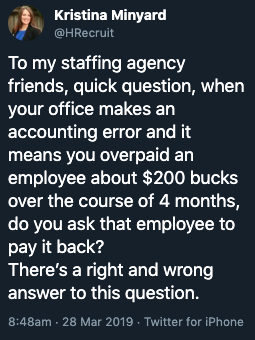I’m in Nashville, TN this week attending and speaking at the SHRM Talent Conference. SHRM Talent has quickly become one of my favorite conferences to attend and speak at because I love being surrounded by TA Pros and Leaders who are in the weeds! Actual real folks, making real placements, with real stories and pain of running corporate TA operations every day! My Peeps!!!!
I was speaking to attendees this week as I was getting ready for my presentation and guess what!?! Every single one had the exact same issue! We all need more people! And, AND, “we” – every freaking one of us – is struggling to find those people to fill our jobs. From San Fran to Dallas to Tampa to Kansas City to Detroit to New York and every small, medium, and large city in between, we are struggling.
So, you are not alone. I am here with you. And though you are far away. I am here to stay. (it’s lyrics to a song I couldn’t get out of my head as I started writing this post!) But it fits!
The cool part of knowing you are in the same boat as everyone else is since we are all in this together, we can help each other. We almost now are in a position where we have to help each other. It’s not okay to what our brothers and sisters in the grind fail.
So, how can we do this? I’ve got a couple of ideas:
1. Local Partnership Candidate Sharing – You have applicants and candidates you are not using. They are unused inventory that for whatever reason you don’t need and won’t hire. You have a peer in your city that is also sitting on an unused inventory of candidates. Go meet for lunch and take those unused, new candidates, and swap. They might be able to use some of yours and you might be able to use some of there candidates. The reality is, this is costing you nothing, and helping both of you! Ramp it up by inviting four or five other leaders from other organizations, and now you’re changing the game!
2. Stop Traditional Employee Referral Programs – Well, Tim, we pay $250 after 90 days of employment. Great, that’s like telling someone you’re giving them $1 Million in Monopoly money! It’s not real to them. They don’t truly believe they’ll ever get that. Start rewarding the behaviors and activities that lead to hires. Hey, here’s a $20 bill for giving us the name and phone number of a candidate, Thank You! Here’s a $50 bill for when the person actually shows up for the interview! Here is a $100 bill when they show up day 1! THANK YOU! Here’s another $50 bill when they are still here on Day 90, or whatever. This will lead to more referrals and cash money in the hand will make this real to your employees and you’ll get more referrals!
3. Stop Making Candidates Jump Through Your Hoops – Well, Tim, if the candidate really wants the job they will come into our office and fill out the application. No, no they won’t. Because your competition isn’t making them, and you’re an idiot! I’ve got 3 Gen Z sons who would all be great hires for any company. Work hard, care about their job, look your customer in the eye and treat them with kindness and respect, but they won’t walk in an fill out your stupid app. But, if you allow them to text you their interest, they will be all in. There is absolutely zero correlation that a candidate who jumps through your hoops will be a good hire, and there is absolutely zero correlation that a candidate who won’t jump through your hoops will be a bad hire. Stop it!
Stop doing this alone. Go invite one peer from another company to meet for lunch or coffee. Start building your local talent network of peers who you can work with to rise all of our boats. There is a time for competition and there is a time for cooperation. Today we need to be working together to solve this talent crisis.


